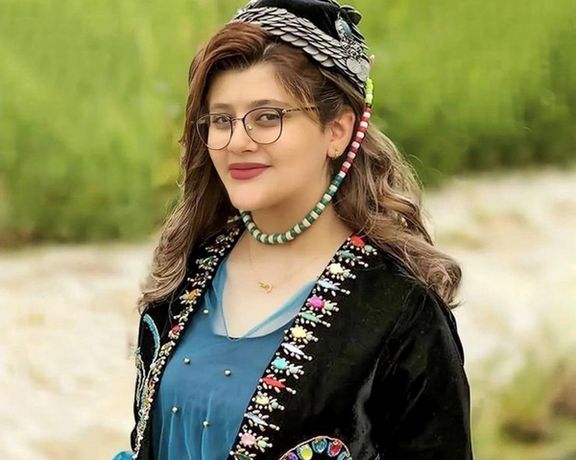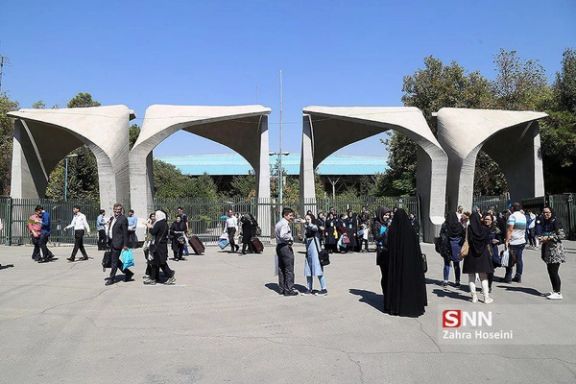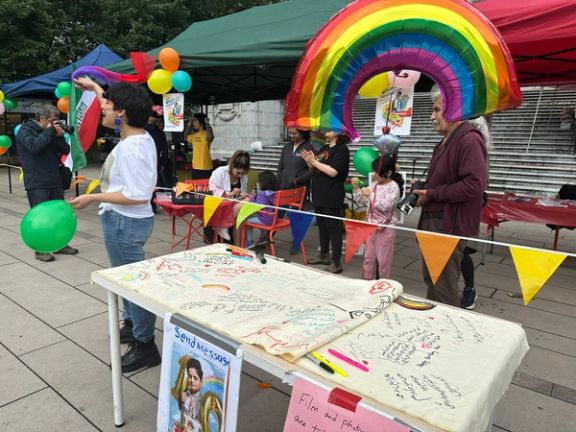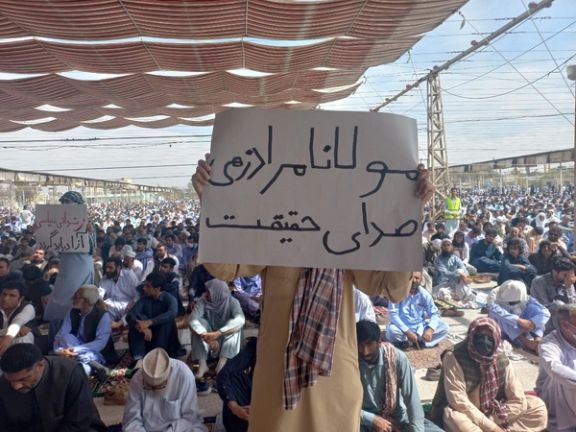Protests In Saqqez Following Damage To Mahsa Amini’s Grave

Protests continued in the Iranian Kurdish city of Saqqez following damage by regime supporters to Mahsa Amini’s grave last month.

Protests continued in the Iranian Kurdish city of Saqqez following damage by regime supporters to Mahsa Amini’s grave last month.
Businesses shut down in protest at the damage to the grave in Aichi cemetery which they have now hidden from view, Amini having become a symbol of the months of uprising since the 22-year-old Kurd was murdered in morality police custody in September.
Amini has become the face of the ‘Woman, Life, Freedom’ movement and the damage at the grave site sparked fury, with regime agents now totally concealing it from view for fear it had become a shrine to the movement’s martyr.
The cemetery has become a common scene of demonstrations against the state-sanctioned murder of protesters since September, many laid to rest alongside Amini.
Last Friday, dozens of victims’ families held pictures of their loved ones in peaceful protest while in a heavy handed response, regime agents arrested and transferred about 40 of them to an unknown location, including six mothers of young victims.
In recent months, the agents of the Islamic Republic have destroyed the graves of those killed in the nationwide protests in different cities of Iran.
The regime has a history of destroying the Khavaran cemetery in the past, and the families of those executed in the 80s have repeatedly protested this.
The cemetery is in southeast Tehran and an unmarked mass graveyard where at least dozens of executed prisoners are buried. Families of victims visit the cemetery regularly and lay flowers, although no one is certain about the exact identity of those buried in Khavaran.

Regime agents in Iran shot and killed a relative of a 9-year-old boy murdered during protests in November, as people gathered at his grave to mark his birthday.
The boy, Kian Pirfalak died when security forces fired at his family car for no apparent reason. Almost overnight, the child became a symbol of regime brutality on social media and during street protests.
Sunday was his 10th birthday and the people of his town Izeh, in the oil-rich province of Khuzestan, tried to gather at the cemetery to commemorate him but faced both regular police and forces sent by the Revolutionary Guard which had deployed in the town to prevent possible protests.
Pouya Molaei-Rad, an 18-year-old student and cousin of Kian’s mother was shot and killed by security agents near the cemetery in unclear circumstances. Eyewitnesses say that there was a confrontation with the police. A video showed the multiple gunshot wounds on the chest.
The government immediately alleged that the young man was driving toward the cemetery when he hit three security personnel and was shot multiple times, dying in hospital later. But the wounds on the victim's chest seem like straight shots, which many people see as evidence that he was not shot inside the car.
The circumstances of the shooting are not entirely clear. Some say he was caught off-guard by the sudden appearance of security forces on the road as he was driving, while the government says he intentionally ran over security agents.
Nevertheless, the incident has turned into a rallying cry for all regime opponents in Iran and abroad.
The child victim and his 18-year-old relative come from the large and fiercely independent Bakhtiari tribal people, which have to a large extent become urbanized, but maintain kinship loyalties.
Their killings will for a long time antagonize ethnic Bakhtiaris toward the Islamic regime. In the tribal culture, no one can rest until revenge is exacted for the killing of a blood kin.
As Kian Perfalak was laid to rest on November 18, his mother Mahmonir (Zaynab) Molaei-Rad made a fiery speech at her son’s grave. She conveyed a strong message of protest against Supreme Leader Ali Khamenei who she seemed to hold directly responsible for her son’s killing.
Iranian opposition figures abroad issued messages Sunday as soon as the news of Molaei’s killing emerged.
Exiled Prince Reza Pahlavi tweeted: “The criminal regime has murdered another of our youth. The name of Pouya Molai-Rad, this young Bakhtiari patriot, has become eternal. This child-killing regime, however, is not eternal.”
He added that the “evil” regime “will be removed and the perpetrators of the murder of Iranian children and youth will face trial. This is a national and unbreakable promise.”
Alireza Akhondi, an Iranian-born member of Sweden’s parliament and an active opposition figure said in a Persian tweet that the day when the “criminal regime will be toppled with the will of the people” is not too far away and vowed that the perpetrators of regime crimes will be held responsible.
US-based opposition figure Masih Alinejad tweeted that even family members of Moalei-Rad and Pirfalak have been arrested after Sunday’s incident.
“The Islamic Republic has become one of the world’s top executioners of its own citizens. The only way the clerical regime has engaged with an educated youthful society is through the muzzle of a gun,” Alinejad said.
Hossein Ronaghi, an opposition activist in Iran and a former political prisoner praised Mahmonir Molaei-Rad, saying that Kian’s mother “is the darling of hearts in Iran…”

Accommodation for a number of female students at the University of Tehran was canceled by the dormitory due to their refusal to wear the mandatory hijab.
Iran's Student Union Council announced on its Telegram channel Saturday that the security office at the Chamran dormitory even asks girls to observe the rules inside their rooms.
The council called the decision "one of the most shameless" actions of Tehran University officials, saying the security forces had also taken photos of the students when they entered or left the dormitory which shows they are collecting documents against the students."
According to the report, female students are now being monitored more strictly and they can only enter the dorm after 10:00 pm once during a semester.
“Even leaving the dormitory after 10 pm has become more difficult and is possible only by presenting a travel ticket or in case of an illness,” read the report.
In March, Iran’s health and education ministries said their educational centers will not be providing services to students who do not observe the mandatory hijab.
Meanwhile, the education ministry in a separate statement announced that women who do not comply with the compulsory hijab will not be allowed to attend classes.
During the nationwide protests in Iran following the death in custody of Mahsa Amini, universities have been the hotbed of protests with hundreds of students arrested, in addition to targeted poisoning attacks on girls’ schools.

On the birthday of Kian Pirfalak, a 9-year-old child killed during anti-regime protests, and a symbol of regime brutality, Iranians abroad held rallies in several countries.
Kian would have turned 10 on June 11 this year, but on the evening of November 16 last year, the family car carrying Kian, his parents, and three-year-old brother Radin was targeted by plainclothesmen in Izeh, a town of around 100,000 in the southwestern oil-rich Khuzestan Province.
Kian’s father was also seriously wounded in the shooting and paralyzed. Authorities claim the family car was attacked by “terrorists”.
The videos received by Iran International show Iranians living in Austria celebrating Kian's birthday by holding a program in Graz on Saturday.
In Sweden, the Iranian diaspora held rallies in Stockholm and Gothenburg to celebrate the birthday of the murdered child.
Similar events were also staged in Copenhagen, Hamburg, Washington, Montreal, Brisbane and several other cities.
On Friday, a group of Iranians living in the UK also marked Kian's birthday by gathering outside the Foreign Office. They urged the British government to fully sanction Iran’s Revolutionary Guard, the IRGC, that leads all repressive military and paramilitary forces in Iran.
Earlier, activists had issued several calls to hold global gatherings on the anniversary of Kian Pirfalak's birthday.
Social media users welcomed Kian’s birthday with the hashtag "rememberingkian" and publishing his photos.
Mahmonir Molaei-Rad, Kian's mother, previously wrote on her Instagram that the security forces raided the house of one of their friends taking away "all the items they had prepared to celebrate Kian's birthday."

In the 36th consecutive Friday of protests against the Islamic Republic in Zahedan, security forces arrested dozens of teenagers and young men in the restive city.
Since protests started nine months ago following the death of Mahsa Amini in custody of hijab police, the regime forces have repeatedly arrested Baluch citizens in large numbers as they kept their street protests alive.
Haalvsh website, which covers the events in Sistan-Baluchestan province, reported that only the identities of a small number of those arrested on Friday, June 9,have been revealed so far, but most of them were under 18.
The campaign of Baluch activists quoted an informed source as saying that plainclothes agents raided and detained these young men as they were returning home after the Friday prayers.
According to Haalvsh, the reason behind their arrests and their whereabouts are not known yet.
The people of Zahedan have been protesting every Friday since September 30, when security forces opened fire on civilians, killing about 90 protesters.
As Sunni Muslims, Baluch citizens are both an ethnic and religious minority. Estimates of the Iranian Baluch population range from 1.5 to 2 million people. The Baluch community – along with the Kurds -- has always been among the most persecuted minorities and has the largest number of people executed in the country.
Most Baluchis are executed over drug-related charges, but activists say their trials lack due process and poverty-stricken drug mules are often executed without having proper legal representation.

Iran’s security forces arrested dozens of families of the victims of state violence in two Kurdish cities where they gathered to commemorate their loved ones.
The families were from the cities of Dehgolan, Sanandaj, Divandareh and Saqqez, who had traveled on Friday to visit the graves of those killed during the nationwide protests in Bukan and Saqqez.
The petitioning families chanted, "We Will Stand Until the End" and "Woman Life Freedom".
In Aichi cemetery in Saqqez, where Mahsa Amini’s body is laid to rest, dozens held the pictures of their loved ones.
However, regime agents arrested and transferred about 40 of them to an unknown location, including six mothers of young victims.
During the recent protests in Iran, ignited by the death in custody of 22-year-old Amini in September 2022, security forces killed hundreds of people and many more received permanent injuries. More than 20,000 people, including university students, actors and journalists were also detained.
The authorities not only failed to accept any responsibility but they put pressure on some of the victims' families who made statements against regime officials during funerals or on social networks. Relatives of many victims killed by the government have been summoned for questioning and arrested.
According to human rights groups, the Islamic Republic has killed over 500 people, including at least 70 children, during its crackdown on the ongoing protests.